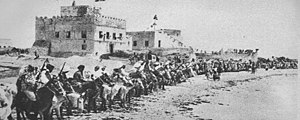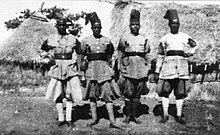Royal Corps of Somali Colonial Troops
| Royal Corps of Somali Colonial Troops | |
|---|---|
Gold Medal of Military Valour |
The Royal Corps of Somali Colonial Troops (Italian: Regio corpo truppe coloniali della Somalia italiana) was the colonial body of the Royal Italian Army based in Italian Somaliland, in present-day northeastern, central and southern Somalia.[1]
History
Establishment
In the late 19th century,
On 5 April 1908, the Royal Corps of Somali Colonial Troops was established, after the Italians had captured the southern
In 1908, the Royal Corps assumed the final name ''Regio corpo truppe coloniali della Somalia italiana. This included a command, a department of
In 1907, the rebels Bimal lost again at Dongab and
Somaliland Campaign
The British became convinced of their need of Italian assistance in their campaign against the

The relationship between the
The expedition ended in failure soon after.
In 1925, the
Second Italo-Ethiopian War & Italian East Africa

During the Second Italo-Ethiopian War, the Somali Colonial Troops served alongside soldiers from Italy and Eritrea in a second attempt by Italian troops to defeat the Ethiopian forces.
In the Battle of the Ogaden, commanded by General Luigi Frusci who was to move forward to the pivotal point of the "Hindenburg Wall" of Ethiopian defenses under Wehib Pasha (a military advisor to the Ethiopian army), the Royal Corps of Somali Colonial troops in April 1936 fought bravely defeating the Ethiopian troops. They received an Italian "Military Gold Medal" award mainly for this victory.
On 5 May 1936, Italian troops captured

The Somali Colonial Troops would then be merged with other
In 1940, the Somali Colonial Troops were officially added to the Italian Army, establishing the Italian Somali Divisions (101 and 102).
After World War II, a former member of the Zaptìé corps, Siad Barre, became President of Somalia from 1969 to 1991.[14]
Honors
![]() Gold Medal of Military Valor - Awarded for heroism during the Italo-Ethiopian War of October 3, 1935 to May 5, 1936.[15]
Gold Medal of Military Valor - Awarded for heroism during the Italo-Ethiopian War of October 3, 1935 to May 5, 1936.[15]
See also
- Italian empire
- Italian Armed Forces
- Italian Somaliland
- Italian Somali Divisions (101 and 102)
- Dubats
- Zaptie
Notes
- ^ "Le colonie italiane - La Somalia". Retrieved 18 January 2017.
- ^ I. M. Lewis, A modern history of Somalia: nation and state in the Horn of Africa, (Westview Press: 1988), p.38
- Ben-Ghiat, Ruth, Italy and its colonies, in A historical companion to postcolonial literatures: continental Europe and Africa, Poddar, Prem, Patke, Rejeev S. and Jensen, Lars eds., Edinburgh: Edinburgh University Press, 2008, p. 310
- ^ Olsen, James Stuart and Shadle, Robert, eds., Historical dictionary of European imperialism, Westport, Conn.: 1991, Greenwood Press, p. 567
- ^ "Le colonie italiane - La Somalia". Retrieved 18 January 2017.
- ^ Omar, Mohamed (2001). The Scramble in the Horn of Africa. p. 402.
This letter is sent by all the Dervishes, the Amir, and all the Dolbahanta to the Ruler of Berbera ... We are a Government, we have a Sultan, an Amir, and Chiefs, and subjects ... (reply) In his last letter the Mullah pretends to speak in the name of the Dervishes, their Amir (himself), and the Dolbahanta tribes. This letter shows his object is to establish himself as the Ruler of the Dolbahanta
- ^ Commander of the torpedo-gunboat Caprera on 14 March, quoted in Hess (1964), 421.
- ISBN 187420991X.
- ^ Sheik-ʻAbdi (1993), 129
- ^ Hess (1964), 421.
- ^ Cunliffe-Owen (1905), 169.
- ^ "Gli altri Bersaglieri". Retrieved 18 January 2017.
- ^ Muntaz (corporal) Unatù Endisciau of the LXXII Zaptié (I° Gruppo Carabinieri) Battalion was the only "soldier of colour" to be awarded personally the Italian Gold Medal of Military Valor - (Article of Arnaldo Grilli on the first two years of World War II (in Italian))
- ^ "Obituary: Mohamed Said Barre". 3 January 1995. Retrieved 18 January 2017.
- ^ web, Segretariato generale della Presidenza della Repubblica-Servizio sistemi informatici- reparto. "Le onorificenze della Repubblica Italiana". Retrieved 18 January 2017.
References
- Hess, Robert L. (1964). "The ‘Mad Mullah’ and Northern Somalia." The Journal of African History 5 (3): 415–33.
- Cunliffe-Owen, Frederick. (1905). "The Somaliland Operations: June, 1903, to May, 1904." Royal United Service Institution Journal 49 (1): 169–83.
- Sheik-ʻAbdi, ʻAbdi ʻAbdulqadir (1993). Divine Madness: Moḥammed ʻAbdulle Ḥassan (1856–1920). Zed Books. ISBN 0862324440.

